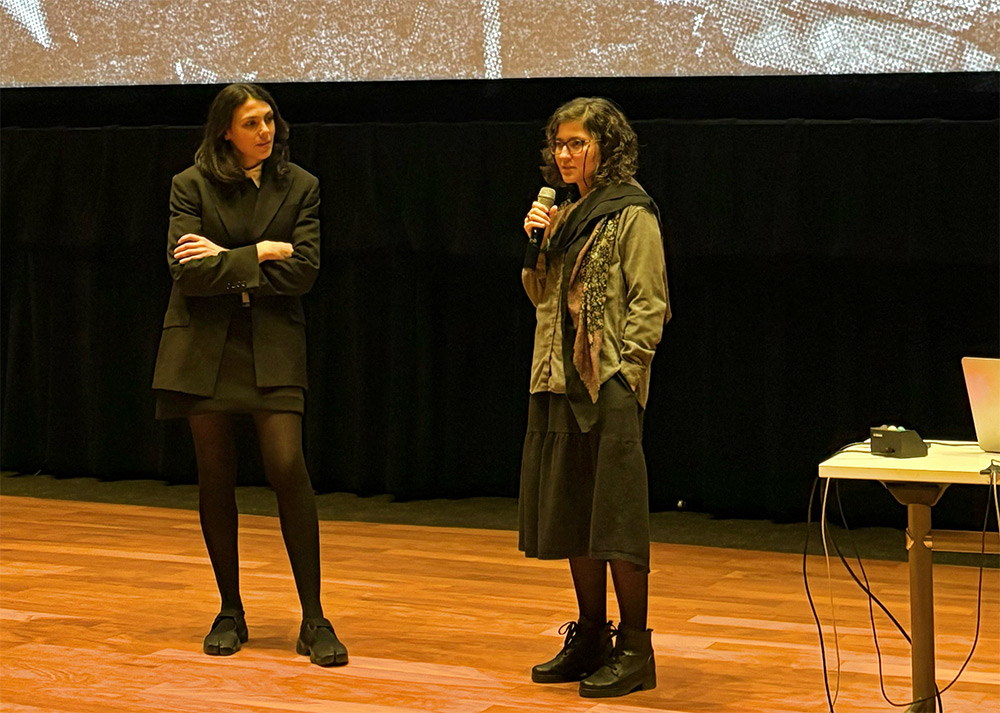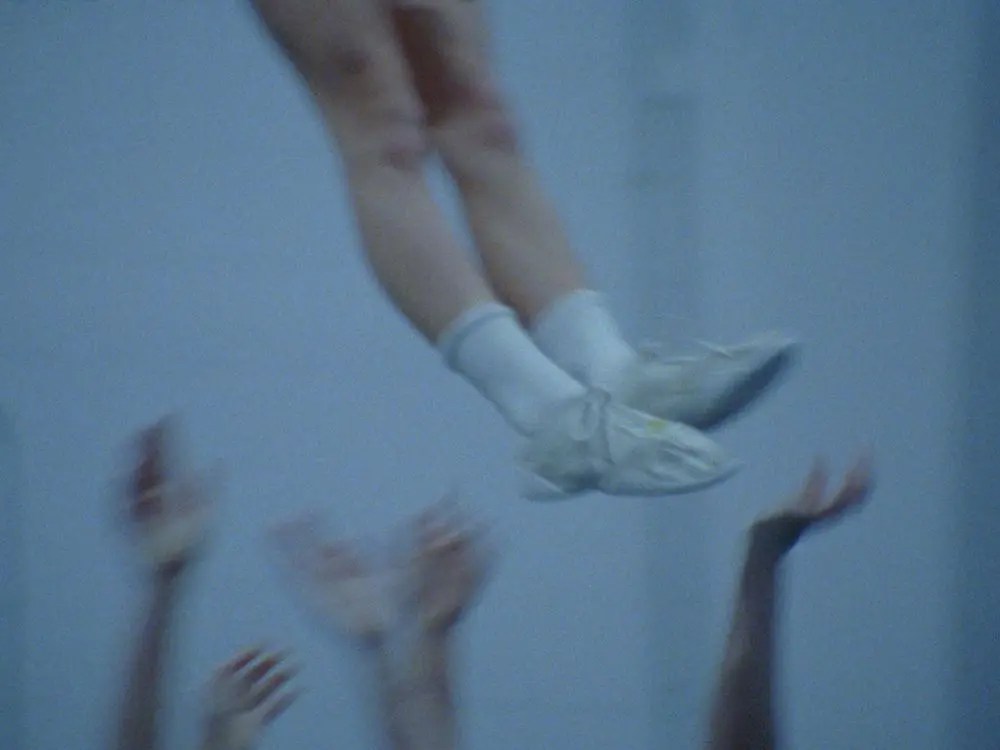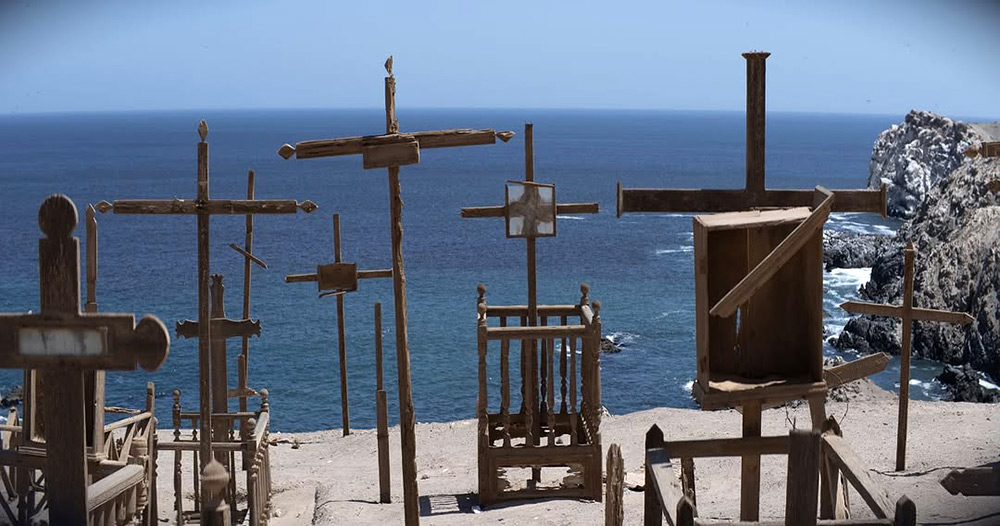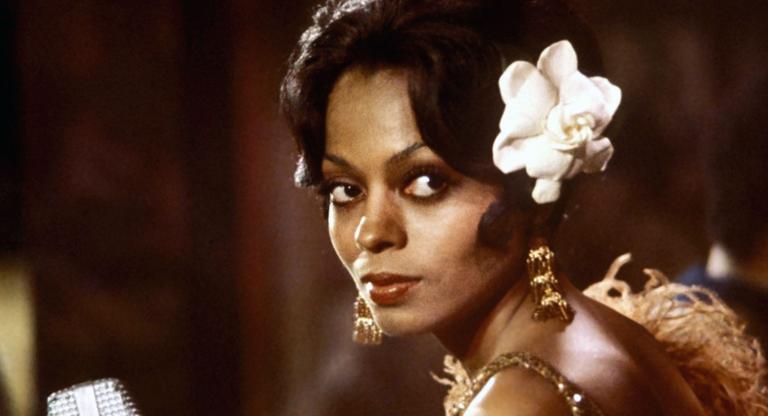Conceived as an avant-garde alternative to the Toronto Festival of Festivals (now colloquially known as TIFF) in 1987, Images is an annual interdisciplinary arts festival known for foregrounding experimental film and installation art. The festival’s contribution to local visual culture cannot be exaggerated, especially now, as the city’s arts scene is blighted by corporate interest and a clear hostility toward Palestinian solidarity. (To paint a picture for our stateside readers, which is most of you, it is somewhat bleak: there are only a handful of repertory cinemas, in some abiding danger of foreclosure, with multiple festivals and collectives shuttering simultaneously. We are also critically lacking in unions.)
Images runs counter to many of the mounting stresses in the industry, and not always blissfully so. The introductions to this year’s screenings included a statement about anti-colonial censorship, particularly the cancellation of Iranian-Canadian artist Parastoo Anoushahpour’s exhibition ultrablue* by Ace Hotel in 2024, after the artist included a citation addressing the ongoing genocide in Palestine. The primary image from that exhibition, a bunch of Gladiolus against a black background, was winkingly repurposed in a 35-second trailer by Anoushahpour for this year’s festival: in close up, a wall is brushed with wheatpaste, then gently rolled over with a poster. Two hands smooth out the creases, then footsteps retreat into the distance, an affirmation of resilience in the face of censure which recalls local postering initiatives.
This year’s festival theme was constellations, as both elemental moving images and sites of gathering. In their introductions, Executive Director Magdalyn Asimakis and Programming Director Jaclyn Quaresma frequently cited Gloria Anzaldúa’s poem “The New Speakers,” which tenders that “We don’t want to be / Stars but parts / of constellations.” Such collectivity is communicated by the festival’s interdisciplinary approach, featuring a number of handsome gallery tie-ins: a partial retrospective of Toronto new media artist Zeesy Powers curated by Kiera Boult at Vtape; a film and accompanying installation by Brooklyn-based artist Suneil Sanzgiri curated by Aamna Muzaffar at Mercer Union; and, a five-pronged multimodal exhibition on collective action curated by Quaresma and Liz Ikiriko at Gallery TPW.
Of the exhibitions, the cardinal draw was a reading by the prolific Caribbean-Canadian poet M. NourbeSe Philip as part of A Smile Split by the Stars at Gallery 44. The venue, a modestly-sized photo gallery, was packed with patrons spanning local film and literary circles; I watched the performance from a seat in an adjacent showroom, with Philip in profile flanked by two canvases. She read for a full 60 minutes, during which stragglers were invited in to sit at the foot of the stage, nodding, snapping, and smiling along. “I’ve started losing faith in things I didn’t know I had faith in,” Philip sighs between excerpts of her work. I scrambled to write down a quote from her 1993 short story “Stop Frame”: “the hard white bone of history.” It conveyed something breakable, which I appreciated.
In the spirit of live presentation, Iranian filmmaker (or, film collagist) Maryam Tafakory led a performance, The Zina of the Eye, after a screening of their films Razeh-del (2024) and Mast-del (2023). (They were originally meant to perform CodeNames II at Images in 2024, but this was cancelled due to extenuating circumstances.) Tafakory’s films appropriate footage from post-revolution Iranian cinema—often the intimate, haptic, and gestural—in order to respell this “archive of betrayal.” The narration carries a history, while the images both facilitate and disrupt it through superimposition and inversion techniques that the filmmaker calls “reciprocal distortion.” In Mast-del, for instance, Tafakory pilfers a certain type of bodily image: wrinkles, knuckles, nail beds, hair follicles; particularities lost within the larger vein of the original films.

Razeh-del, which had its World Premiere at Locarno last year, constellates newsprint and film footage to inhabit the history of Zan, Iran’s first women’s newspaper, through the perspective of two schoolgirls in 1998 submitting a synopsis for an “impossible film.” Tafakory meticulously lines the film with comments and complaints from the paper’s direct line column, which often communicate a nasty, chauvinistic rhetoric. The images are beautifully assembled to both underline and cross out such messaging: “They were inside us,” says Tafakory, referring to a policing mentality, as the screen cuts to an image of pearls being strung.
Tafakory’s first performance in Canada, The Zina of the Eye, involved a semi-elaborate setup: an audio mixer, timer, microphones, miscellaneous wiring, and the filmmaker’s laptop. They elected to do a simplified version of the performance (presumably sans live editing), with written fragments narrated over the film in real time. In the dark, Tafakory croons into a microphone in alternating Farsi and English. In cautious intervals, they turn knobs which warble and crinkle the film’s sounds. It begins with looping images of flowers tugged from the root and cups of spilling milk; a beheading is described over images of fists kneading dough; myths, history, and allegory congeal.
Each year, Images also hosts curatorial residents who build a portion of the program. This year’s residents included Kate Wong, who curated six experimental shorts thematizing transcendence as a political act; Heather Canlas Rigg, who curated the Oaxacan pseudo-doc Passage of the Spiral (2024); and the Camelia Committee, who curated twin programs that consider methods of contamination between the body and the landscape. It was this last committee—comprising filmmakers/editors Mira Adoumier, Carine Doumit and Nour Ouayda—that absorbed much of my attention over the weekend.
Conceived as a diptych, their two programs, A Thousand Landscapes and A Thousand Bodies (inspired by Félix Guattari and Gilles Deleuze’s A Thousand Plateaus), included a total of 10 short films on the subject of mapping territories large and small, be that a desert, a globe, or a torso. Relatedly, two elemental essay films played during the festival: Sanaz Sohrabi’s One Image, Two Acts (curated by Canlas Rigg) and Denise Ferreira da Silva and Arjuna Neuman’s Ancestral Clouds Ancestral Claims (pictured at top), the latter of which was remarkable.
On Sunday morning, Images held a curatorial talk, entirely in French, with Adoumier and Ouayda at Le Laboratoire d’art. They discussed folie as a mode of bodily resistance, as well as the tension of embracing both care and violence in their programs. At one point, the conversation even veered into biomimicry and soil biology as a kind of programming strategy—a single organism changing the nature of the soil around them. I nodded along, adding affectionate oohs and aahs, for, as I later expressed to Ouayda, when it comes to French, I’ve lost my tongue but not my ear.

Playing as part of A Thousand Bodies, Sarah Ballard’s Full Out takes up Guattari and Deleuze’s assertion that symptoms are not fixed indicators of disorder, but methods of bodily resistance. The film flits between medical journal images of the Salpêtrière Hospital in 19th century Paris, where patients were hypnotized to feign hysteria onstage as part of a “clinic,” and the present-day, as a fainting epidemic afflicts high school cheerleaders. This contagion suggests some collective bodily infraction, at times uncannily resembling Lucile Hadzihalilovic’s Innocence (2004). Full Out blends synchronicity and spectacle in indelible ways; the tuning of a piano into an abrasive montage of hand-springing cheerleaders, and the idea that the singular can modulate the collective. Here, Ballard manages an aesthetic rigor many cannot even dream of.
Images also held the World Premiere of filmmaker-activist John Greyson’s wonderfully chimeric Door Prize. A project 13 years in the making, Door Prize begins with the murder of a trans bike courier in Toronto during a double transit of Mars and Venus. The aptly-named Mars (Chase Joynt) is killed by an SUV, launching a city-wide conspiracy in the form of a silent hourly true crime broadcast on TTC (Toronto’s public transit network) platform screens. Hosted in ASL by Mars’s cousin (Alexandra Hickox), these black-and-white episodes see Detective Epicene (Alexander Chapman) evaluating crime scenes and uncovering clues in the form of sign language.
Simultaneously, an identical trans activist-archivist also named Mars is developing a memorial for the 375 trans people murdered in 2021, taking the form of personalized arias and artwork for each individual. Is he a double? A ghost? A paranoiac envisioning his own demise? Or does he see himself reflected in each trans life lost? As Mars’s fixation on his slain doppelganger grows, a wider corporate conspiracy unfolds, involving a corrupt mayor (Arsinée Khanjian) greenwashing the city by replacing subway service with subterranean bike routes—a hilarious fixture which comes shortly after the city’s controversial anti-bike lane bill in 2024.
Door Prize arrives at a moment of heightened threats toward transgender and gender-nonconforming people, who are being mutually targeted and barred from recognition in public life. In the time between writing and publishing this dispatch, the UK Supreme Court ruled that the legal definition of woman excludes trans women, a decision which elucidates a long-running transphobic rhetoric and sets an unnerving precedent for the enforcement of “biological” binaries.
In Door Prize, Greyson’s approach is impressive and full-flavored—unlike anything I’ve seen before. It incorporates true crime pastiche, elegiac interludes, and floating-head interviews, all colored by the myth of Orpheus. “Is all artistic work about trans life about violence?” Joynt asks in voice-over, a question which tugs at the project itself. In this 38th iteration of Images, such contradiction is both welcome and vital in understanding our constellating moment.




